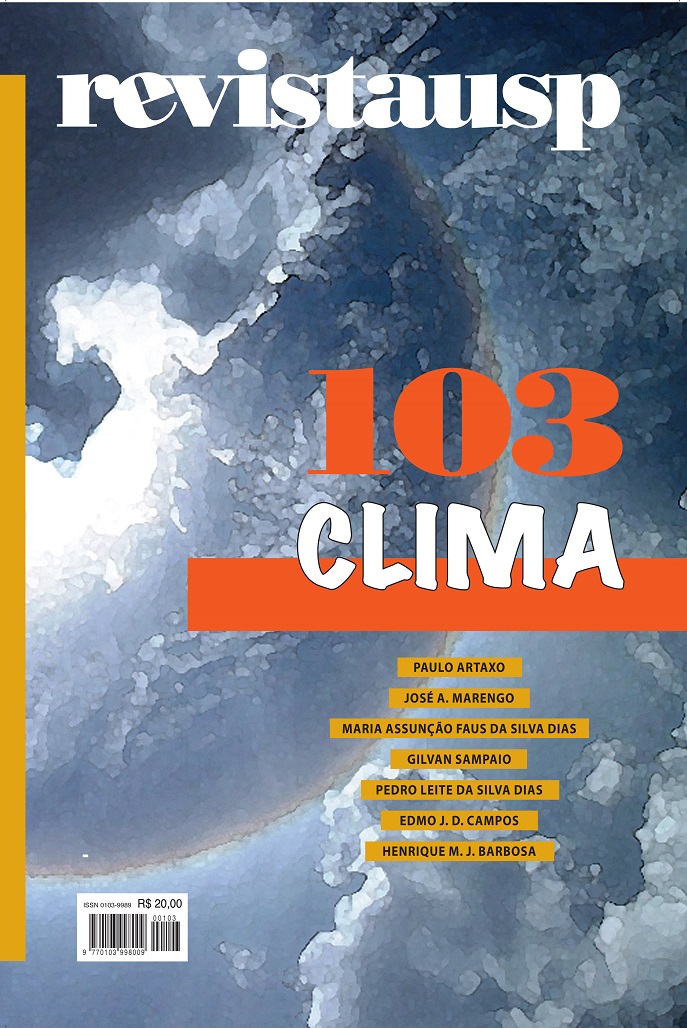Uma nova era geológica em nosso planeta: o Antropoceno?
DOI:
https://doi.org/10.11606/issn.2316-9036.v0i103p13-24Palavras-chave:
mudanças globais, mudanças climáticas, poluição atmosférica, gases de efeito estufa, eras geológicas.Resumo
Nosso planeta seguiu uma evolução determinada pelas forças geológicas desde sua origem, há cerca de 4,5 bilhões de anos. Ao longo dessa jornada, passou por transformações significativas em sua crosta e atmosfera. Com o início da Revolução Industrial, na segunda metade do século XVIII, um novo agente de mudança se somou às transformações geológicas. O rápido crescimento populacional – somos 7,3 bilhões de habitantes hoje, e seremos cerca de 10 bilhões em 2050 –, associado ao uso excessivo de recursos naturais, fez com que muitos indicadores de saúde da Terra saíssem da região segura. A partir de 1950, o desenvolvimento humano e suas implicações no ecossistema terrestre crescem exponencialmente. Atualmente, uma grande fração das áreas continentais sem gelo é ocupada por atividades humanas como agricultura e urbanização, entre outras.
Downloads
Referências
ANDREAE, M. O. et al. “Smoking Rain Clouds Over the Amazon”, in Science 303, 2004, pp. 1.337-42.
ARTAXO, P. et al. “Atmospheric Aerosols in Amazonia and Land Use Change: from Natural Biogenic to Biomass Burning Conditions”, in Faraday Discussions, 165, 2013, pp. 203-35.
ARTAXO, P. et al. “Perspectivas de Pesquisas na Relação entre Clima e o Funcionamento da Floresta Amazônica”, in Ciência e Cultura, ISSN 2317-6660, v. 66, n. 3, 2014, pp. 41-6.
BOUCHER, O. et al. “Clouds and Aerosols”, in Climate Change 2013: The Physical Science Basis. Contribution of Working Group I to the Fifth Assessment Report of the Intergovernmental Panel on Climate Change. Edited by T. F. Stocker et al. United Kingdom/New York, Cambridge University Press, Cambridge, 2013.
COMPREHENSIVE Assessment of Water Management in Agriculture. Water for Food, Water for Life: a Comprehensive Assessment of Water Management in Agriculture. London, Earthscan and International Water Management Institute, 2007.
CRUTZEN, P. J. “Geology of Mankind”, in Nature, 415, 23, 2002.
FOLEY, J. A. et al. “Global Consequences of Land Use”, in Science 309, 2005, pp. 570-4.
FORSTER, P. et al. “Changes in Atmospheric Constituents and in Radiative Forcing”, in Climate Change 2007: The Physical Science Basis. Contribution of Working Group I to the Fourth Assessment Report of the Intergovernmental Panel on Climate Change. Edited by S. Solomon et al. Cambridge, Cambridge University Press, 2007.
HELMUS, M. R. et al. “Phylogenetic Measures of Biodiversity”, in Am. Nat,. v. 169, n. 3, 2007, pp. E68-E83.
IGBP – International Geosphere-Biosphere Programme. Great Acceleration. Disponível em: http://www.igbp.net/globalchange/greatacceleration.4.1b8ae20512db692f2a680001630.html. Acesso em: 20/2/2015.
IPCC – Intergovernmental Panel on Climate Change. Managing the Risks of Extreme Events and Disasters to Advance Climate Change Adaptation. Special report of Working Groups I and II of the IPCC. Edited by C. B. Field et al. Cambridge,
Cambridge University Press, 2012.
IPCC – Intergovernmental Panel on Climate Change. Climate Change 2013: The Physical Science Basis. Summary for Policymakers. Prepared by L. Alexander et al. IPCC Secretariat, Geneva, Switzerland, 2013.
MACE, G. M. et al. “Approaches to Defining a Planetary Boundary for Biodiversity”, in Glob. Environ. Change, 28, 2014, pp. 289-97.
REDMAN, C. L. Human Impact on Ancient Environments. Tucson, AZ, University of Arizona Press, 1999, 239 pp.
RICHARDSON, K. et al. “Synthesis Report. Climate Change: Global Risks, Challenges & Decisions”, in Summary of the Copenhagen Climate Change Congress, 10-12 March 2009. Copenhagen, University of Copenhagen, 2009.
ROCKSTRÖM, J. et al. “A Safe Operating Space for Humanity”, in Nature, 461, 2009, pp. 472-5.
ROCKSTRÖM, J. et al. “Planetary Boundaries: Exploring the Safe Operating Space for Humanity”, in Ecol. Soc., 14, 32, 2009.
RUNNING, S. W. “A Measurable Planetary Boundary for the Biosphere”, in Science, 337, 2012, pp. 1.458-9.
SCHELLNHUBER, Hans-Joachim et al. Earth System Analysis for Sustainability. Dahlem Workshop Report, 2004.
SCHOLES, R. J.; BIGGS, R. “A Biodiversity Intactness Index”, in Nature, 434, 2005, pp. 45-9.
SENA, E. T.; ARTAXO, P.; CORREIA, A. L. “Spatial Variability of the Direct Radiative Forcing of Biomass Burning Aerosols and the Effects of Land Use Change in Amazonia”, in Atmospheric Chemistry and Physics, 13, 2013, pp. 1.261-75.
STEFFEN, W. et al. Global Change and the Earth System: A Planet Under Pressure. The IGBP Book Series, Springer-Verlag, Berlin, Heidelberg, New York, 2004.
STEFFEN, W.; CRUTZEN, J.; MCNEILL, J. R. “The Anthropocene: Are Humans now Overwhelming the Great Forces of Nature?”, in Ambio, v. 36, n. 8, 2007, pp. 614-21.
STEFFEN, W. et al. “Planetary Boundaries: Guiding Human Development on a Changing Planet”, in Science, v. 347, 2015a, pp. 736-46.
STEFFEN, W. et al. “The Trajectory of the Anthropocene: The Great Acceleration”, in The Anthropocene Review, 1-18, 2015b.
WHO – World Health Organization. Burden of Disease from the Joint Effects of Householdand Ambient Air Pollution for 2012. http://www.who.int/phe/health_topics/outdoorair/databases/AAP_BoD_results_March2014.pdf.
Downloads
Publicado
Edição
Seção
Licença
Copyright (c) 2015 Revista USP

Este trabalho está licenciado sob uma licença Creative Commons Attribution-NonCommercial-ShareAlike 4.0 International License.
|
Pertence à revista. Uma vez publicado o artigo, os direitos passam a ser da revista, sendo proibida a reprodução e a inclusão de trechos sem a permissão do editor. |


